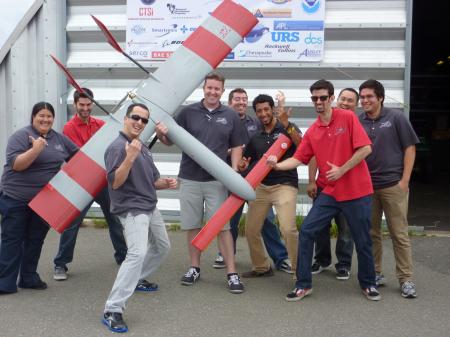 From left, students Nadine Menjuga, David Penniman, Ruben Cuellar, Scott Schultz (team lead), James Zimmerman, Hakim Bachmid, Ulysses Marquez, Pipat Jetawatana, and Andres Chavez[/img]
From left, students Nadine Menjuga, David Penniman, Ruben Cuellar, Scott Schultz (team lead), James Zimmerman, Hakim Bachmid, Ulysses Marquez, Pipat Jetawatana, and Andres Chavez[/img]
The CSUN entry in this year Unmanned Aerial Systems Competition really took flight, placing third overall against 35 other entrants. Like the IGV, the UAS competition is sponsored by AUVSI.
An interdisciplinary team of 33 students from mechanical engineering, electrical and computer engineering, civil engineering and computer science designed and built the robotic aircraft, dubbed FF 12 (Flying Fox 2012), which functioned as an airborne observation, search and relay platform.
“The competition rules start out with the idea that you are going to submit a proposal for military procurement and design an unmanned aerial system (UAS) to carry out a mission, doing as much autonomously as possible,” explains Tim Fox, the professor of mechanical engineering who advised the team.
Within a 40-minute flight window, the aircraft must take off, fly past a series of waypoints and search an open area for objects on the ground, finding and characterizing them and feeding the information back to competition sponsors. A new element this year was to use the aircraft as a remote Wi-Fi relay link and communicate with another computer on the ground.
The 2012 event, the tenth UAS competition, was held in mid-June at the Pax River Naval Air Station in Maryland and was the third that CSUN had entered. Last year, the college’s team placed sixth overall.
